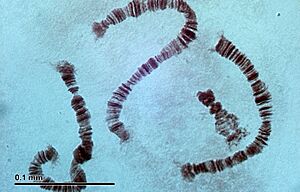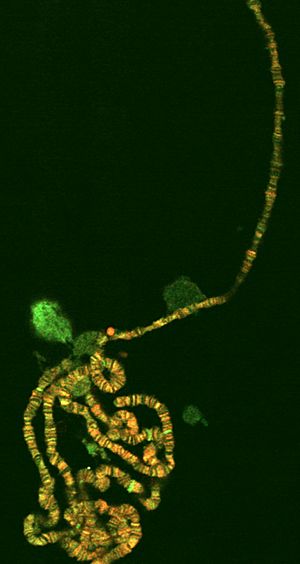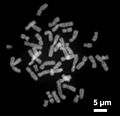Chromosome facts for kids
The chromosomes are tiny structures found inside the cell nucleus of almost every living thing. They are super important because they carry all the genetic information that makes you, you! Think of them as tiny instruction manuals for your body.

(1) Chromatid – one of the two parts of the chromosome after duplication.
(2) Centromere – the point where the two chromatids touch.
(3) Short arm. (4) Long arm.

Chromosomes are made from DNA and protein all wrapped up together. Each chromosome holds many different genes. Genes are like small sections of the instruction manual that tell your body how to grow, what color your eyes should be, and so much more.
Most living things that have a cell nucleus (these are called eukaryotes) have chromosomes. This means you'll find them in plants, animals, fungi, and many other tiny organisms.
Contents
Chromosomes and Cell Division
When your body needs to make new cells, like when you're growing or healing a cut, your cells divide. This process is called mitosis. Before a cell divides, it makes an exact copy of all its chromosomes.
When they are copied, chromosomes look like the letter "X". Each half of the "X" is called a chromatid. These two identical halves are joined together in the middle at a spot called the centromere.
Human Chromosomes
Humans have 46 chromosomes in total, which means they have 23 pairs. You get one set of 23 chromosomes from your mother and another set of 23 from your father. These pairs match up, carrying similar instructions.
Among these 23 pairs, one pair is special: the sex chromosomes. These determine if you are male or female.
- A mother's egg always carries an X chromosome.
- A father's sperm can carry either an X or a Y chromosome.
If an egg (X) meets a sperm (X), the child will be female (XX). If an egg (X) meets a sperm (Y), the child will be male (XY).
To make sex cells (like eggs and sperm), special cells go through a different division process called meiosis. This process reduces the number of chromosomes from 23 pairs (which is called diploid) down to 23 single chromosomes (called haploid). When an egg and sperm combine during fertilization, they create a new cell with the full 23 pairs again.
Chromosome Differences
Different animals have different numbers of chromosomes. For example, humans have 46, but a dog has 78!
Sometimes, a person might not have the usual number of chromosomes. This can lead to certain conditions or genetic disorders. For instance:
- Down syndrome happens when a person has an extra copy of chromosome 21.
- Klinefelter syndrome occurs in males who have an extra X chromosome (XXY instead of XY).
These conditions show how important it is for chromosomes to be just right.
Polytene Chromosomes
Polytene chromosomes are very large chromosomes that are much bigger than normal ones. They form in special cells that make many copies of their DNA without the cell actually dividing. This means many identical copies of the DNA stay stuck together side-by-side, making a giant chromosome.
You can find polytene chromosomes in some insects, like Drosophila (fruit flies) and nonbiting midges. They are also in some other tiny creatures and even in certain plant cells.
These large chromosomes are important for cells that need to produce a lot of something quickly. For example, in fruit fly larvae, the cells that make saliva have polytene chromosomes. This helps them produce a lot of glue before they turn into a pupa.
Sometimes, you can see "puffs" on polytene chromosomes. These puffs are areas where the chromosome is uncoiled and very active, making lots of specific proteins or other molecules that the cell needs.
Related pages
- Karyotype
- Cell division
- Homologous chromosome
- Human genome
- Mutation#Chromosome mutations
- Genetics#Between Mendel and modern genetics
Images for kids
-
Human chromosomes during metaphase
See also
 In Spanish: Cromosoma para niños
In Spanish: Cromosoma para niños







